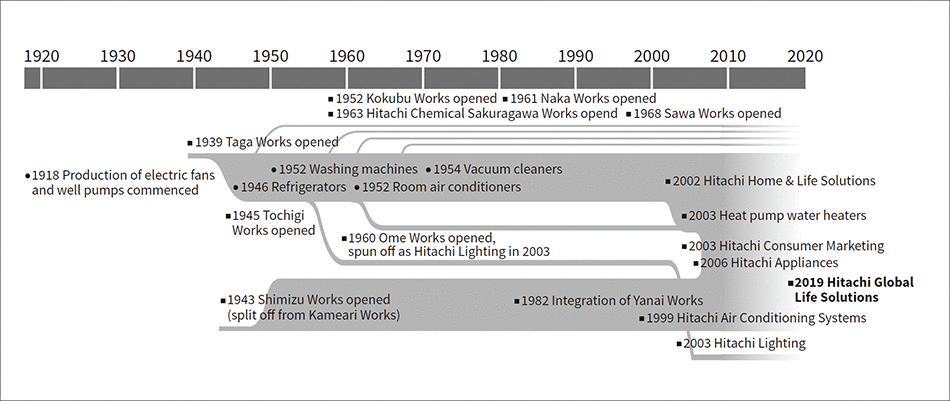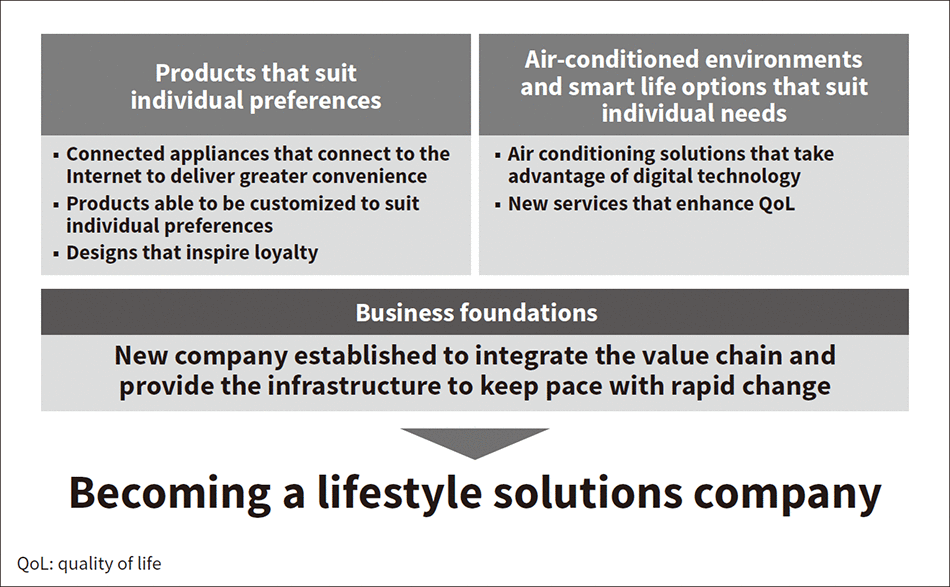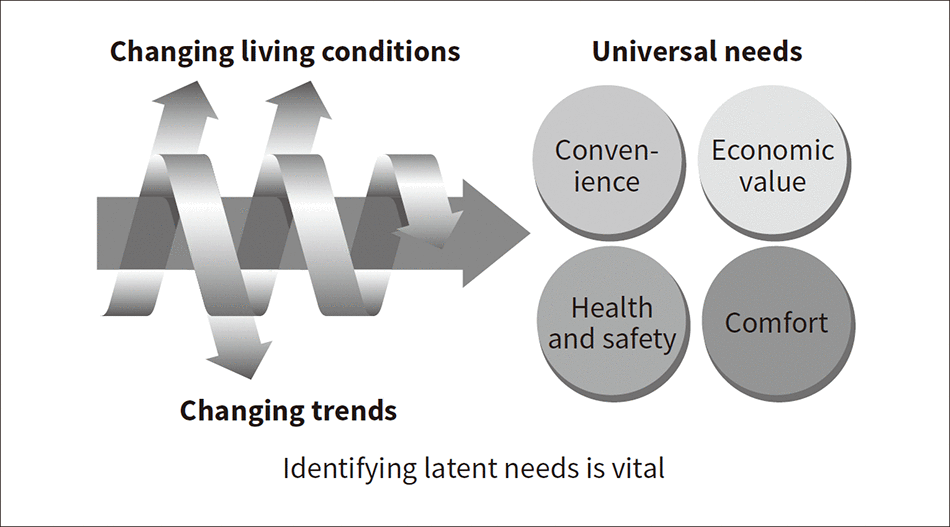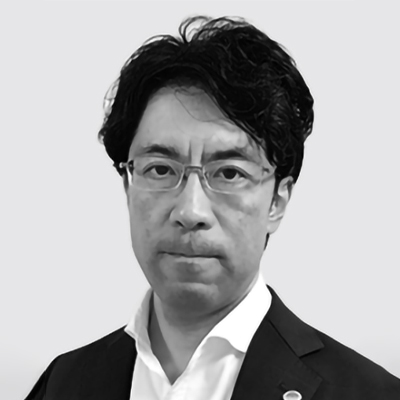OverviewCreation of New Value for Diverse LifestylesBecoming a Lifestyle Solutions Company that Enhances QoL
Highlight
The lifestyles of people everywhere are becoming increasingly diverse amid a steady stream of new products and services as digital technology drives the rapid pace of innovation. At the same time, a rising number of complex societal challenges are emerging that demand attention.
Formed by the merger of Hitachi Consumer Marketing, Inc. and Hitachi Appliances, Inc., Hitachi Global Life Solutions, Inc. aims to be a lifestyle solutions company that applies digital technology to the Smart Life sector and engages with people everywhere to enhance the quality of life of its customers through the supply of products and services that overcome the challenges of daily life.

1. Introduction
Having identified the Smart Life sector as a priority to focus on, Hitachi established Hitachi Global Life Solutions, Inc. (Hitachi GLS) in April 2019 to take over leadership of its appliance and air conditioning business in the digital era. The new company started out through the merger of Hitachi Consumer Marketing, Inc. and Hitachi Appliances, Inc. (see Figure 1).
Innovation driven by digital technology has been advancing at a rapid pace around the world in recent years, with a steady stream of new products and services appearing on the market. Meanwhile, the world is also seeing ongoing developments in the efforts being made to address complex societal challenges, including initiatives aimed at realizing Society 5.0 and the Sustainable Development Goals (SDGs). All of this is being accompanied by increasing diversity in the lifestyles led by people everywhere.
While Hitachi successfully structured its operations around separate sales and manufacturing companies back when business was based on a “product-out” model, it was decided that consolidating these operations would be better suited to the coming shift to a market-oriented business model. Moreover, given that a sense of speed has become more important than ever in the conduct of business, it was felt that now was the time to undertake the transformation to the new company.
The intention is that the merger will speed up not only decision making, but also the supply of products, solutions, and services. It is also the part of Hitachi’s business that is positioned more closely than any other to the lives of its customers, and the intention also is to take advantage of this in the delivery of Smart Life products and services based on digital technology. In doing so, Hitachi GLS is seeking to become a lifestyle solutions company that enhances the quality of life (QoL) of its customers by engaging with people in their increasingly diverse lifestyles and offering solutions to the challenges they face (see Figure 2).
Fig. 1—History of Hitachi’s Appliance Business The new company was formed from the merger of Hitachi Consumer Marketing, Inc. and Hitachi Appliances, Inc.
The new company was formed from the merger of Hitachi Consumer Marketing, Inc. and Hitachi Appliances, Inc.
Fig. 2—Aims of Hitachi Global Life Solutions The aim is to become a lifestyle solutions company that enhances customers’ QoL.
The aim is to become a lifestyle solutions company that enhances customers’ QoL.
2. Product Manufacturing
Since 2006, Hitachi has pursued what it calls its “premium strategy” whereby it has sought to offer products that bring innovation to daily life by supplying customers with attractive value, developing unique functions, and with the pursuit of energy efficiency as a core feature.
Figure 3 shows what the experience of developing products for this premium strategy has taught Hitachi about the universal needs that all consumers have with respect to home appliances.
Fig. 3—Customer Needs The key challenge is how to identify latent needs.
The key challenge is how to identify latent needs.
Fig. 4—BD-NX120C Front-loading Washer Dryer with Heat Recycling The washer dryer’s Wind Iron function relieves the drudgery of ironing.
The washer dryer’s Wind Iron function relieves the drudgery of ironing.
While the emphasis may vary, these four universal needs are always present, with economic value and health and safety forming a common platform that requires constant effort to maintain. Likewise with comfort and convenience, Hitachi is seeking to deliver products that satisfy more customers by using a high level of skill and original ideas to achieve these in response to increasingly diverse customer needs.
Examples of how Hitachi has adopted a customer’s perspective to deliver attractive value include the “Wind Iron” function that removes wrinkles using jet air while drying in a washer dryer, an automatic tub-cleaning function that cleans the washing tub with clean water before dirt has a chance to adhere to it, a vacuum compartment for refrigerators that keeps food fresh by suppressing oxidation, and an imaging camera for air conditioners that maintains a comfortable environment by using a sensor to detect when family members or others are present in the room (see Figure 4).
Recent demographic changes such as a much higher percentage of elderly, low birth rates, and an increasing number of small (single- or two-person) households are bringing major changes to how people live and what they want from home appliances. The growing diversity of customers and their needs has become an important consideration in product development, something that has been brought about by changing lifestyles such as the rapid increase in the number of dual-income households as more women enter the workforce. Although particularly evident in Japan, these changes in the structure of society can be seen as a challenge shared by the entire world.
Along with new measures for satisfying increasingly diverse customer needs by further pursuing its premium strategy in the face of these structural changes in society, Hitachi has embarked on product development that seeks to deliver even more attractive value under the slogan, “360-degrees of happiness: a happy life for each and every customer”.
The aim is to shift to a customer-centric approach to development that listens carefully to what all customers have to say and engage with them in their lives so as to identify the issues that really matter, drawing on high levels of skill and original ideas to resolve those concerns. Hitachi is also working on advanced connected appliances that use software to adapt to how customers live and how they use these products, the aim being to utilize manufacturing capabilities and digital technologies built up over time to add new value.
Using not only the products themselves, but also digital technologies and services as a means of satisfying increasingly diverse needs is as important for appliances as it is in other fields. When supplying solutions to the challenges of daily life, what is needed alongside existing practices for identifying how customers really live and the latent needs of which they themselves are not yet aware is to augment these approaches with the development of desirable future scenarios, using this as a way of anticipating upcoming issues and building up a portfolio of ideas and solutions for addressing them. Accordingly, Hitachi is introducing a new technique called “vision-based product development” that envisages how people might live in the future and how their attitudes may change, using backcasting techniques to come up with products, functions, and service ideas that address these changes.
When developing products for a global market, it also becomes more important to think in terms of the customer’s perspective and to study and analyze the factors that need to be considered in appliance development, including those that differ from place to place such as living practices and customs, as well as the “cold chain” and other aspects of food distribution. Accordingly, a new facility was established at Hitachi Consumer Products (Thailand), Ltd. (HCPT) in April 2017 to undertake development based on the views of customers in different parts of the world, serving the same role as the Lifestyle Research Center that studies the opinions, behaviors, and attitudes of customers in Japan.
3. Activities in Different Sectors
This issue of Hitachi Review carries articles describing products and solutions designed to adapt to changes in customer lifestyles. These articles are summarized below.
- Development of products that meet individual needs
The product range based on the concept of “360-degrees of happiness: a happy life for each and every customer,” includes an induction cooker and robot cleaner, refrigerators with selectable zone, ligtht weight cordless stick vacuum cleaners, front-loading washer-dryers that incorporate artificial intelligence (AI), and the Shirokuma-kun X series of stainless clean room air conditioners with Frost Wash Fan Robo. This article also describes the development process and sales strategy for a front-loading washing machine aimed at the Southeast Asian market, using this as an example of the work being done by the Global Product Development Center in Thailand. - Development of home appliances for better QoL through customization, automation, and ease-of-use
This article presents examples of the research and development of technologies tailored to the individual needs of the customers who use them, and that enhance QoL by overcoming lifestyle challenges. These include the analysis-led design of a new layout for customizable refrigerators, equipping vacuum cleaners with higher suction power and lighter weight to make them easier to use, an automatic detergent and softener dispensing mechanism, an AI-based washer-dryers that adjusts the wash program automatically based on the condition of the machine, and Frost Wash Fan Robo for room air conditioners that automatically deals with the build-up of dust on the fan. - Home appliance recycling for a resource-efficient society
As an early starter in the field of home appliance recycling, Hitachi has been involved in the recycling business on its own account as well as through its pursuit of technology development based on government direction and industry collaboration. This has also included the use of plastic from appliance recycling in new home appliances. This article describes an apparatus for removing glass wool as an example of the pre-emptive development of environmental technology based on recycling technology built at a pilot plant for appliance recycling. - Development of remote monitoring/predictive diagnosis service “exiida” for air conditioning
Hitachi has started supplying the exiida remote monitoring/predictive diagnosis service of air conditioning that uses the collection and analysis of large amounts of operational data from air conditioning and refrigeration equipment to identify the warning signs of potential faults so that remedial action can be taken before they happen. This article gives an overview of the service and the state of development of the technology for pre-emptive fault detection that delivers both economic and social value. The economic value the technology delivers reduces business losses while maintaining a comfortable environment, while the social value it provides reduces harm to the environment by minimizing the release of freon coolant and also addresses the problem of workplace staff shortages by spreading the maintenance workload that would otherwise happen mainly during the summer. - Air conditioning solution for regenerative medicine
Hitachi draws on the technology it has built up over time for the precise control of temperature, humidity, cleanliness, and air pressure to supply the regenerative medicine industry with air conditioning solutions for cell production facilities. Along with an overview of the solution and details of clean room features and collaborative creation with other companies, this article also includes information about the Regenerative Medicine Innovation Center. - IoT-based improvements in home appliance manufacturing at Hitachi GLS
Hitachi GLS is improving its manufacturing practices with the aim of enhancing efficiency by getting rid of process steps that do not add any value, making improvements and eliminating barriers and bottlenecks, and also through cell automation and system-wide optimization of the links between individual processes. This article describes the work being done on using Internet of Things (IoT) systems to improve total supply chain management based on the concepts of enhancing transparency and connectivity while reducing reliance on particular individuals.
4. Conclusions
Through these and other initiatives, Hitachi GLS aims to become a lifestyle solutions company that enhances people’s QoL by utilizing original ideas and technologies to engage with customers and overcome the challenges they face. It also intends to continue working on the development of products and services that will contribute to the aims laid out in Hitachi’s 2021 Mid-term Management Plan of enhancing social, environmental, and economic value.
REFERENCES
- 1)
- Y. Ishii, “What Should We Make—Giving Shape to Customers’ Latent Needs,” Hitachi Hyoron 91, pp. 338–343 (Apr. 2009) in Japanese.
- 2)
- K. Watanabe et al., “Evolution to Meet Customer Needs—Technologies for Better Life,” Hitachi Hyoron, 92, pp. 726–733 (Oct. 2010) in Japanese.




